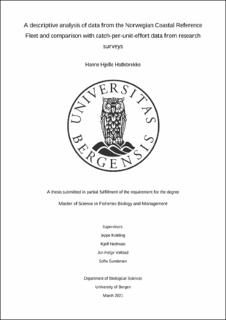| dc.description.abstract | Catch quotas are used for the sustainable management of fish stocks and are based on official catch statistics and research surveys. However, these methods provide only partial information, as the official catch data does, at best, include only rough measures of effort, and the survey data are only collected at certain times of the year. In 2005, the Norwegian Coastal Reference Fleet (CRF) was established by the Institute of Marine Research (IMR), in order to register catches per species including size- and age composition, discards, bycatch, gear, and effort as representable for the Norwegian coastal fishing fleet as possible. These data have not yet been comprehensively explored and visualised, and this thesis is a first attempt at making a general description of the CRF data. Between 2007-2019, a total of 64 fishing vessels participated in the CRF along the Norwegian coast collecting data on a cumulated 287 taxa from 29 137 individual fishing operations stratified by statistical areas. The most common species was cod (Gadus morhua), which occurred in 60.9% of the fishing operations. Throughout the study period, the gear composition of the CRF shifted in most areas along the coast, however gillnet was the most common gear in all years. Catch per unit effort (CPUE) standardises catch data for comparisons in both space and time and is often used as a proxy for abundance, assuming constant catchability. However, catchability varies with factors such as the target species, gear, season, and area. When collecting fishery independent data during the IMR’s Coastal Survey, the gear, locations, and timings are fixed between years to reduce variability in catchability. How the fishery dependent CPUE trends followed the survey trends for the selected species cod, haddock (Melanogrammus aeglefinus), and golden redfish (Sebastes norvegicus was therefore explored. When comparing mean annual CPUE from the CRF with the Coastal Survey index, the timeseries for cod followed each other closely over the entire study period and especially north of 67°N. The CPUE timeseries for haddock were less similar, and for golden redfish the two datasets showed very different trends. This is likely due to the imposed moratorium on this species from 2014. The results indicate that with large samples and over annual periods, the mean variability in the CRF catchability is evened out, however selective targeting and fishery restrictions make direct comparisons between fishery dependent and -independent data challenging. The CRF does, however, offer an insight into the nature of the fisheries, and together with surveys the two data sets complement each other to better understand the dynamics and impacts of a fishery. | |
